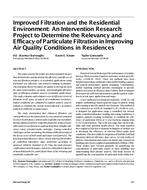Description
This paper reports the results of a field evaluation project that demonstrates and documents the efficiency and efficacy of selected filtration products in residential applications using fractional size efficiency and particle-counting techniques. The emerging interest in indoor air quality is driving the need for more representative, accurate, and meaningful efficiency data on filtration products used in residential applications. This study evaluates and compares several efficiency levels of filtration in all zones of typical air-conditioned residences. Indoor conditions are compared to outdoor particle concentrations to establish the overall system efficiency of particle reduction within the occupied space.
The study documented that enhanced filtration can consistently lower the indoor particle concentration compared to low or no filtration. Commercially available one-inch filters having enhanced particle reduction properties reduced respirable particles at efficiencies approaching those of higher efficiency rated, extended media cartridges. During controlled challenges such as vacuuming, the enhanced filtration reduced the decay cycles of both small and larger sized particles. The field fractional efficiency curves closely followed the profiles of controlled laboratory data performed according to proposed ASHRAE Standard 52.2P. Thus, the study provides confirmation of performance claims for substantial reduction of household particles, particularly those of the irritating and potentially respirable size.
Authors: H.E. (Barney) Burroughs, Kevin E. Kinzer, Taylor Gonsoulin
Citation: IAQ and Energy 98 Using ASHRAE Standards 62 and 90.1 Conference Papers
Keywords: October, Louisiana, 1998
Citation: IAQ Conference: IAQ 98
Product Details
- Published:
- 1998
- File Size:
- 1 file , 910 KB
- Product Code(s):
- D-8123




